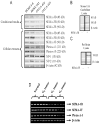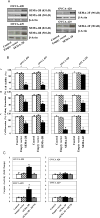Hormonal regulation and distinct functions of semaphorin-3B and semaphorin-3F in ovarian cancer
- PMID: 20124444
- PMCID: PMC2820590
- DOI: 10.1158/1535-7163.MCT-09-0664
Hormonal regulation and distinct functions of semaphorin-3B and semaphorin-3F in ovarian cancer
Abstract
Semaphorins comprise a family of molecules that influence neuronal growth and guidance. Class-3 semaphorins, semaphorin-3B (SEMA3B) and semaphorin-3F (SEMA3F), illustrate their effects by forming a complex with neuropilins (NP-1 or NP-2) and plexins. We examined the status and regulation of semaphorins and their receptors in human ovarian cancer cells. A significantly reduced expression of SEMA3B (83 kDa), SEMA3F (90 kDa), and plexin-A3 was observed in ovarian cancer cell lines when compared with normal human ovarian surface epithelial cells. The expression of NP-1, NP-2, and plexin-A1 was not altered in human ovarian surface epithelial and ovarian cancer cells. The decreased expression of SEMA3B, SEMA3F, and plexin-A3 was confirmed in stage 3 ovarian tumors. The treatment of ovarian cancer cells with luteinizing hormone, follicle-stimulating hormone, and estrogen induced a significant upregulation of SEMA3B, whereas SEMA3F was upregulated only by estrogen. Cotreatment of cell lines with a hormone and its specific antagonist blocked the effect of the hormone. Ectopic expression of SEMA3B or SEMA3F reduced soft-agar colony formation, adhesion, and cell invasion of ovarian cancer cell cultures. Forced expression of SEMA3B, but not SEMA3F, inhibited viability of ovarian cancer cells. Overexpression of SEMA3B and SEMA3F reduced focal adhesion kinase phosphorylation and matrix metalloproteinase-2 and matrix metalloproteinase-9 expression in ovarian cancer cells. Forced expression of SEMA3F, but not SEMA3B in ovarian cancer cells, significantly inhibited endothelial cell tube formation. Collectively, our results suggest that the loss of SEMA3 expression could be a hallmark of cancer progression. Furthermore, gonadotropin- and/or estrogen-mediated maintenance of SEMA3 expression could control ovarian cancer angiogenesis and metastasis.
Figures






Similar articles
-
Progesterone and 1,25-dihydroxyvitamin D₃ inhibit endometrial cancer cell growth by upregulating semaphorin 3B and semaphorin 3F.Mol Cancer Res. 2011 Nov;9(11):1479-92. doi: 10.1158/1541-7786.MCR-11-0213. Epub 2011 Sep 20. Mol Cancer Res. 2011. PMID: 21933904
-
Expression of class 3 semaphorins and their receptors in human breast neoplasia.Histopathology. 2011 Aug;59(2):274-82. doi: 10.1111/j.1365-2559.2011.03922.x. Histopathology. 2011. PMID: 21884206
-
The role of the plexin-A2 receptor in Sema3A and Sema3B signal transduction.J Cell Sci. 2014 Dec 15;127(Pt 24):5240-52. doi: 10.1242/jcs.155960. Epub 2014 Oct 21. J Cell Sci. 2014. PMID: 25335892
-
Role of class 3 semaphorins and their receptors in tumor growth and angiogenesis.Clin Cancer Res. 2009 Nov 15;15(22):6763-70. doi: 10.1158/1078-0432.CCR-09-1810. Epub 2009 Nov 3. Clin Cancer Res. 2009. PMID: 19887479 Review.
-
Semaphorins in cancer.Front Biosci. 2005 Jan 1;10:751-60. doi: 10.2741/1569. Print 2005 Jan 1. Front Biosci. 2005. PMID: 15569615 Review.
Cited by
-
Semaphorin 3F and Netrin-1: The Novel Function as a Regulator of Tumor Microenvironment.Front Physiol. 2018 Nov 23;9:1662. doi: 10.3389/fphys.2018.01662. eCollection 2018. Front Physiol. 2018. PMID: 30532711 Free PMC article. Review.
-
Hormone response in ovarian cancer: time to reconsider as a clinical target?Endocr Relat Cancer. 2012 Nov 9;19(6):R255-79. doi: 10.1530/ERC-12-0175. Print 2012 Dec. Endocr Relat Cancer. 2012. PMID: 23045324 Free PMC article. Review.
-
Semaphorins and Their Roles in Breast Cancer: Implications for Therapy Resistance.Int J Mol Sci. 2023 Aug 23;24(17):13093. doi: 10.3390/ijms241713093. Int J Mol Sci. 2023. PMID: 37685898 Free PMC article. Review.
-
Role of Neuropilin-2-mediated signaling axis in cancer progression and therapy resistance.Cancer Metastasis Rev. 2022 Sep;41(3):771-787. doi: 10.1007/s10555-022-10048-0. Epub 2022 Jul 1. Cancer Metastasis Rev. 2022. PMID: 35776228 Free PMC article. Review.
-
The emerging role of class-3 semaphorins and their neuropilin receptors in oncology.Onco Targets Ther. 2014 Sep 24;7:1663-87. doi: 10.2147/OTT.S37744. eCollection 2014. Onco Targets Ther. 2014. PMID: 25285016 Free PMC article. Review.
References
-
- Comeau MR, Johnson R, DuBose RF, et al. A poxvirus-encoded semaphorin induces cytokine production from monocytes and binds to a novel cellular semaphorin receptor, VESPR. Immunity. 1998;8:473–82. - PubMed
-
- Tamagnone L, Artigiani S, Chen H, et al. Plexins are a large family of receptors for transmembrane, secreted, and GPI-anchored semaphorins in vertebrates. Cell. 1999;99:71–80. - PubMed
-
- Winberg ML, Noordermeer JN, Tamagnone L, et al. Plexin A is a neuronal semaphorin receptor that controls axon guidance. Cell. 1998;95:903–16. - PubMed
-
- Luo Y, Raible D, Raper JA. Collapsin, a protein in brain that induces the collapse and paralysis of neuronal growth cones. Cell. 1993;75:217–27. - PubMed
-
- Kolodkin AL, Matthes DJ, Goodman CS. The semaphorin genes encode a family of transmembrane and secreted growth cone guidance molecules. Cell. 1993;75:1389–99. - PubMed
Publication types
MeSH terms
Substances
Grants and funding
LinkOut - more resources
Full Text Sources
Medical
Miscellaneous

